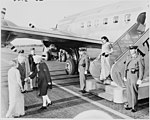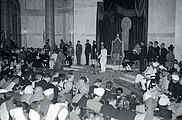Fowler&fowler (talk | contribs) →top: removing gratuitous nonsense about GVI. He is not mentioned even in the pages on Britain in WW2; The Blitz; Rationing in London; how then is he hogging real estate in the lead of India? Removing |
Fowler&fowler (talk | contribs) →George VI as King of India: removing entire section; OR in the service of an archaic British POV; this kind of detail does not belong to India |
||
| Line 77: | Line 77: | ||
File:Dr. Babasaheb Ambedkar, chairman of the Drafting Committee, presenting the final draft of the Indian Constitution to Dr. Rajendra Prasad on 25 November, 1949.jpg|[[B. R. Ambedkar]], chairman of the Drafting Committee of the [[Constitution of India]] presenting the final draft to [[Rajendra Prasad]], president of the [[Constituent Assembly of India]], 25 November 1949 |
File:Dr. Babasaheb Ambedkar, chairman of the Drafting Committee, presenting the final draft of the Indian Constitution to Dr. Rajendra Prasad on 25 November, 1949.jpg|[[B. R. Ambedkar]], chairman of the Drafting Committee of the [[Constitution of India]] presenting the final draft to [[Rajendra Prasad]], president of the [[Constituent Assembly of India]], 25 November 1949 |
||
File:Rajagopalachari declares India as a Republic.jpg|Governor-General Rajagopalachari declares India a Republic at Darbar Hall on 26 January 1950 |
File:Rajagopalachari declares India as a Republic.jpg|Governor-General Rajagopalachari declares India a Republic at Darbar Hall on 26 January 1950 |
||
</gallery> |
|||
==George VI as King of India== |
|||
[[File:Badge of the Monarchy of India (1947-50).png|thumb|upright=0.6|The [[Heraldic badge|badge]] of the monarch of India (1947–1950)]] |
|||
Under the [[Indian Independence Act 1947]], [[British India]] was to be divided into the independent sovereign states of India and [[Dominion of Pakistan|Pakistan]].<ref>{{cite ODNB|url=http://www.oxforddnb.com/view/article/33370|title=George VI|access-date=20 April 2008|last=Matthew|first=H. C. G.|date=September 2004|doi=10.1093/ref:odnb/33370|quote=India and Pakistan remained among the king's dominions but both were set on republican courses, becoming republics within the Commonwealth in 1950 and 1956 respectively.}}</ref> From 1947 to 1950, George VI was the sovereign of India, which shared the same person as its sovereign with the [[United Kingdom]] and the other [[Dominion]]s in the British [[Commonwealth of Nations]].<ref name=unionofindia /><ref name="Harshan">{{citation|last1=Kumarasingham|first1=Harshan|title=THE 'TROPICAL DOMINIONS': THE APPEAL OF DOMINION STATUS IN THE DECOLONISATION OF INDIA, PAKISTAN AND CEYLON, vol. 23| url=https://www.jstor.org/stable/23726109?seq=1 |year=2013|publisher=Transactions of the Royal Historical Society|pages=223|quote=Few today, including those who work on the subcontinent, recollect that India, Pakistan and Sri Lanka did not become republics the day British rule ended. Even distinguished scholars of Empire like Perry Anderson and A. G. Hopkins have made the common assumption that India naturally became a republic upon independence on 15 August 1947. Instead, all three of these South Asian states began their independent life as Realms within the British Commonwealth and mirrored the style and institutions of the Dominions of Canada, Australia, South Africa and New Zealand. Though their sovereignty was in no way impaired by this seemingly ambiguous position they all held the British sovereign as their head of state who was represented in each capital by a governor- general appointed on the advice of the local prime minister. India, Pakistan and Ceylon were Realms from 1947 to 1950, 1947 to 1956 and 1948 to 1972 respectively.}}</ref><ref name=dailyo>{{cite web|last=Panickar |first=Sreejith |date=15 August 2015 |title=Why August 15 should not be Independence Day |url=https://www.dailyo.in/politics/august-15-independence-day-dominion-nehru-mountbatten-king-george-vi-republic-day-constitution/story/1/5680.html |work=DailyO |access-date=26 February 2021}}</ref><ref>{{cite web|last=Daniyal |first=Shoaib |date=15 August 2015 |title=Five things you didn't know about India's Independence Day |url=https://scroll.in/article/674450/five-things-you-didnt-know-about-indias-independence-day|work=Scroll.in |access-date=26 February 2021}}</ref><ref>{{cite web|date=15 August 2020 |title=Did India really achieve freedom in 1947?|url=https://www.deccanherald.com/national/did-india-really-achieve-freedom-in-1947-873663.html|work=Deccan Herald |access-date=26 February 2021}}</ref> The monarch's constitutional roles were mostly carried out by the [[governor-general of India]].<ref name="Harshan"/> |
|||
Following India's independence, King George VI continued to confer awards and honours in the Dominion of India in his name. Most of them were awarded on the advice of "His Majesty's Indian Ministers".<ref>{{London Gazette |issue=38313 |date=4 June 1948 |page=3401 |supp=3 }}</ref><ref>{{London Gazette |issue=38630 |date=3 June 1949 |page=2833 |supp=3 }}</ref><ref>{{London Gazette |issue=38799 |date=30 December 1949 |page=39 |supp=3 }}</ref> |
|||
On 28 April 1948, the prime minister of the Dominion of India, [[Jawaharlal Nehru]] advised King George VI that [[Chakravarti Rajagopalachari]] should succeed [[Lord Mountbatten]] as the next governor-general of India.<ref name=remini>{{citation|title=Reminiscences of the Nehru Age|url=https://www.google.co.in/books/edition/Reminiscences_of_the_Nehru_Age/WDduAAAAMAAJ |date=1978|publisher=Vikas Publishing House|work=M. O. Mathai|isbn=9781578660667|pages=22}}</ref> |
|||
On 22 June 1948, King George VI and [[Queen Elizabeth The Queen Mother|Queen Elizabeth]] abandoned the titles king-emperor and queen-empress.<ref>{{cite book|last=Townsend|first=Peter|title=The Last Emperor|publisher=Weidenfeld and Nicolson|year=1975|isbn=978-0-297-77031-2|location=London|author-link=Peter Townsend (RAF officer)}}</ref> The Indian Cabinet desired the country to become a republic, but not to leave the Commonwealth as a consequence of no longer having George VI as king, as happened to Ireland. The issue came to a head in April 1949 at a [[1949 Commonwealth Prime Ministers' Conference|Commonwealth prime ministers' meeting in London]]. Under the [[London Declaration]], devised by [[Canadian prime minister]] [[Louis St. Laurent]], [[India]] agreed that, when it became a republic in January 1950, it would remain in the Commonwealth and accept the British sovereign as a "symbol of the free association of its independent member nations and as such the Head of the Commonwealth". Upon hearing this, George VI told the Indian politician [[Krishna Menon]]: "So, I've become 'as such'".<ref>{{cite web|url=http://www.indianexpress.com/news/staying-loyal-to-george/581730/0|title=Staying loyal to George|work=indianexpress.com}}</ref> |
|||
The monarchy was abolished on 26 January 1950, when India adopted a new constitution and became a [[Republics in the Commonwealth of Nations|republic within the Commonwealth]], the first Commonwealth country to do so.<ref name="Winegard 2011 2"/><ref>{{cite web|last=Beg |first=Sahil M |date=15 August 2020 |title=For dominion India, real independence did not come in 1947 |url=https://indianexpress.com/article/research/independence-day-dominion-status-august-15-1947-6555454/|work=The Indian Express |access-date=26 February 2021}}</ref> |
|||
===Gallery=== |
|||
<gallery class="center" widths="170px"> |
|||
File:1 Indian rupee coin, 1947.jpg|King George VI, on the obverse of the last one rupee coin of the [[British Raj]], issued in 1947. The [[Coins of the Indian rupee|imperial coins]] with the King's portrait were retained and remained in circulation till 1950.<ref>{{cite web|title=Republic India Coinage|url=https://rbi.org.in/Scripts/mc_republic.aspx|access-date=9 May 2021|work=Reserve Bank Of India|quote=India won its independence on 15th August, 1947. During the period of transition India retained the monetary system and the currency and coinage of the earlier period and introduced a new distinctive series of coins on 15th August, 1950. ...[The Anna Series] was introduced on 15th August, 1950 and represented the first coinage of Republic India. The King's Portrait was replaced by the Lion Capital of the Ashoka Pillar.}}</ref> |
|||
KGVI rupees 5 note cdd front obverse.jpg|Following independence in 1947, George VI banknote series continued to be legal tender till 1950 when post-independence notes were issued.<ref>{{cite web|title=British India Issues|url=https://rbi.org.in/scripts/pm_britishindia.aspx|access-date=13 May 2021|work=Reserve Bank Of India|quote=The George VI series continued till 1947 and thereafter as a frozen series till 1950 when post independence notes were issued.}}</ref> |
|||
File:Jawaharlal Nehru seeking His Majesty's approval.jpg|Jawaharlal Nehru's letter to King George VI requesting approval for the nomination of C. Rajagopalachari as the second Governor-General of India; George VI assent is indicated on the top left and signed GR.<ref>Letter also published in {{citation|title=Reminiscences of the Nehru Age|url=https://www.google.co.in/books/edition/Reminiscences_of_the_Nehru_Age/WDduAAAAMAAJ |date=1978|publisher=Vikas Publishing House|work=M. O. Mathai|isbn=9781578660667|pages=22}}</ref> |
|||
File:Indian Independence Medal 1947 (Obverse).jpg|The [[Indian Independence Medal]] created in 1948 bearing the Royal Badge of India and the inscription ''GEORGIUS VI'' (Latin: George VI) |
|||
File:UN Treaty Series - vol 33 (page 12 crop).jpg|A 1948 friendship treaty between India and Switzerland, carried out in the name of King George VI<ref>{{citation|title=Treaty of Friendship & Establishment|date=14 August 1948|publisher=Ministry of External Affairs, Government of India|url=https://mea.gov.in/bilateral-documents.htm?dtl/5163/Treaty+of+Friendship+amp+Establishmenthttps://mea.gov.in/bilateral-documents.htm?dtl/5163/Treaty+of+Friendship+amp+Establishment|access-date=31 May 2021|archive-date=9 May 2021|archive-url=https://web.archive.org/web/20210509032810/https://mea.gov.in/bilateral-documents.htm?dtl/5163/Treaty+of+Friendship+amp+Establishmenthttps://mea.gov.in/bilateral-documents.htm?dtl/5163/Treaty+of+Friendship+amp+Establishment}}</ref> |
|||
</gallery> |
</gallery> |
||
Revision as of 16:21, 19 September 2021
Union of India | |||||||||
|---|---|---|---|---|---|---|---|---|---|
| 1947–1950 | |||||||||
| Capital | New Delhi | ||||||||
| Government | Constitutional monarchy[2] | ||||||||
| King | |||||||||
• 1947–1950 | George VI | ||||||||
| Governor-General | |||||||||
• 1947–1948 | Lord Mountbatten | ||||||||
• 1948–1950 | Chakravarti Rajagopalachari | ||||||||
| Prime Minister | |||||||||
• 1947–1950 | Jawaharlal Nehru[3] | ||||||||
| Legislature | Constituent Assembly | ||||||||
| History | |||||||||
| 15 August 1947 | |||||||||
• Republic | 26 January 1950 | ||||||||
| Area | |||||||||
| 1950 | 3,287,263 km2 (1,269,219 sq mi) | ||||||||
| Currency | Indian rupee | ||||||||
| |||||||||
| Today part of | |||||||||
The Dominion of India,[4] officially the Union of India,[5] was an independent dominion in the British Commonwealth of Nations existing between 15 August 1947 and 26 January 1950. It came into existence after the passage of the Indian Independence Act 1947 and lasted until 1950, whereupon India became a republic within the Commonwealth with a president as head of state.[6]
Formation
Since the late 1920s the Indian independence movement had been demanding Pūrṇa Swarāj (complete self-rule) for the Indian nation and the establishment of the Dominion of India and the Dominion of Pakistan was a major victory for the Swarajis. Nevertheless, the Partition was controversial among the people, and resulted in significant political instability and displacement.[7]
The 1946 Cabinet Mission to India proposed 'Union of India' as a political unit that would encompass both British India and the Indian princely states.[8] The Mission's plan did not come into fruition due to disagreements over the powers to be held by the Union government. On 3 June 1947, it was decided that British India would be partitioned into two sovereign states, both dominions: Pakistan, consisting of Muslim-majority regions, and India, consisting of the rest. In deference to the wishes of Indian National Congress, it was accepted that the partition would be regarded as the Muslim majority areas splitting off from India.[9]
The Partition of India took place on 15 August 1947,[10] leading to the creation of Pakistan (which later split into the Islamic Republic of Pakistan and the People's Republic of Bangladesh in 1971) and India.
Most of the 565[11] princely states within Indian territory acceded to the Dominion of India. The Hindu-majority Junagadh State located in modern-day Gujarat attempted to accede to Pakistan under Nawab Sir Muhammad Mahabat Khanji III, who was a Muslim. It was annexed militarily by the Indian government. Similarly, the State of Hyderabad sought to remain independent and was also annexed by India in 1948.[7]
History
The newly created states of India and Pakistan both joined the Commonwealth, a platform for cooperation between the countries that had been part of the British Empire. Nevertheless, they soon found themselves at war that began in October 1947, over the contested princely state of Jammu and Kashmir. Pakistani militants entered the state, alarming Maharaja Hari Singh who appealed to India for military intervention, in exchange for the signing of the Instrument of Accession and annexation into India. The region is contested to this day, and two other Indo-Pakistan wars occurred as part of the Kashmir conflict.[7]
Gallery
-
Lord Mountbatten swearing in Jawaharlal Nehru as the first prime minister of the Dominion of India on 15 August 1947
-
Jawaharlal Nehru delivering his 'Tryst with Destiny' speech at Parliament House in New Delhi during the midnight session of the Constituent Assembly on 14–15 August 1947
-
The 3 1⁄2 annas stamp showing the tricolour Flag of India (for foreign surface mail) issued 15 August 1947
-
Emergency trains crowded with desperate refugees following the partition of the British Indian Empire
-
Mahatma Gandhi's ashes on a carriage being drawn by soldiers of the Indian army for immersion in the Triveni Sangam, Allahabad, February 1948
-
Prime ministers of the Commonwealth with King George VI (5th fr left), London 13 October 1948; Don Stephen Senanayake, Ceylon (2nd fr left); Liaquat Ali Khan, Pakistan (3rd fr left); C. R. Attlee (UK, 5th fr right) and Jawaharlal Nehru of India (far right).[12]
-
Nehru being received at the Washinton National Airport by the President Harry S. Truman, 11 October 1949
-
B. R. Ambedkar, chairman of the Drafting Committee of the Constitution of India presenting the final draft to Rajendra Prasad, president of the Constituent Assembly of India, 25 November 1949
-
Governor-General Rajagopalachari declares India a Republic at Darbar Hall on 26 January 1950
Notes
- ^ See Sino-Indian War of 1962.
- ^ See territorial exchanges between India and Bangladesh (India–Bangladesh enclaves).
References
| History of India |
|---|
 |
| Timeline |
- ^ "Press Communique' - State Emblem" (PDF). Press Information Bureau of India - Archive. Archived (PDF) from the original on 24 February 2018.
{{cite web}}:|archive-date=/|archive-url=timestamp mismatch; 8 August 2017 suggested (help) - ^ Cite error: The named reference
dailyowas invoked but never defined (see the help page). - ^ As Prime Minister of India until 1964.
- ^ Multiple sources:
- ^ *Winegard, Timothy C. (2011), Indigenous Peoples of the British Dominions and the First World War, Cambridge University Press, p. 2, ISBN 978-1-107-01493-0 Quote: “The first collective use (of the word "dominion") occurred at the Colonial Conference (April to May 1907) when the title was conferred upon Canada and Australia. New Zealand and Newfoundland were afforded the designation in September of that same year, followed by South Africa in 1910. These were the only British possessions recognized as Dominions at the outbreak of war. In 1922, the Irish Free State was given Dominion status, followed by the short-lived inclusion of India and Pakistan in 1947 (although India was officially recognized as the Union of India). The Union of India became the Republic of India in 1950, while the became the Islamic Republic of Pakistan in 1956.”
- ^ Winegard, Timothy C. (2011), Indigenous Peoples of the British Dominions and the First World War, Cambridge University Press, pp. 2–, ISBN 978-1-107-01493-0
- ^ a b c India: A History. New York, USA: Grove Press. 2000. ISBN 978-0-8021-3797-5.
- ^ Menon, Vapal Pangunni (2015), Transfer of Power in India, Princeton University Press, p. 264, ISBN 978-1-4008-7937-3
- ^ Pande, Aparna (2011), Explaining Pakistan’s Foreign Policy: Escaping India, Routledge, p. 178, note 52, ISBN 978-1-136-81894-3
- ^ Section 1 of the Indian Independence Act, 1947
- ^ "Indian Princely States before 1947 A-J".
- ^ Capie, David (2012), "Asia and New Zealand - War, empire and the new Commonwealth", Te Ara - the Encyclopedia of New Zealand, retrieved 19 September 2021
Bibliography
- Bose, S.; Jalal, A. (2011), Modern South Asia: History, Culture, Political Economy (3rd ed.), Routledge, ISBN 978-0-415-77942-5
- Brown, J. M. (1994), Modern India: The Origins of an Asian Democracy, The Short Oxford History of the Modern World (2nd ed.), Oxford University Press, ISBN 978-0-19-873113-9
- Copland, I. (2001), India 1885–1947: The Unmaking of an Empire (1st ed.), Longman, ISBN 978-0-582-38173-5
- Kulke, H.; Rothermund, D. (2004), A History of India, 4th, Routledge, ISBN 978-0-415-32920-0
- Ludden, D. (2002), India and South Asia: A Short History, One World, ISBN 978-1-85168-237-9
- Metcalf, B.; Metcalf, T. R. (2006), A Concise History of Modern India (2nd ed.), Cambridge University Press, ISBN 978-0-521-68225-1
- Robb, P. (2001), A History of India, London: Palgrave, ISBN 978-0-333-69129-8
- Sarkar, S. (1983), Modern India: 1885–1947, Delhi: Macmillan India, ISBN 978-0-333-90425-1
- Stein, B. (1998), A History of India (1st ed.), Oxford: Wiley-Blackwell, ISBN 978-0-631-20546-3
- Stein, B. (2010), Arnold, D. (ed.), A History of India (2nd ed.), Oxford: Wiley-Blackwell, ISBN 978-1-4051-9509-6
- Wolpert, S. (2003), A New History of India (7th ed.), Oxford University Press, ISBN 978-0-19-516678-1

![Emblem[1] of India](https://upload.wikimedia.org/wikipedia/commons/thumb/d/db/Emblem_of_India_%28without_motto%29.svg/60px-Emblem_of_India_%28without_motto%29.svg.png)
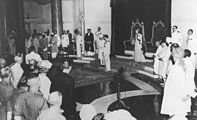

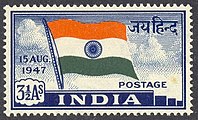
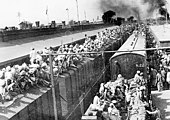
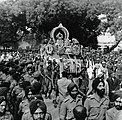
![Prime ministers of the Commonwealth with King George VI (5th fr left), London 13 October 1948; Don Stephen Senanayake, Ceylon (2nd fr left); Liaquat Ali Khan, Pakistan (3rd fr left); C. R. Attlee (UK, 5th fr right) and Jawaharlal Nehru of India (far right).[12]](https://upload.wikimedia.org/wikipedia/commons/thumb/6/66/GVI_Attlee_and_Prime_Ministers_of_the_Commonwealth_London_1948_13_October.jpg/145px-GVI_Attlee_and_Prime_Ministers_of_the_Commonwealth_London_1948_13_October.jpg)
